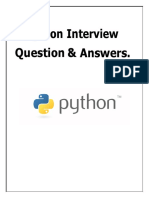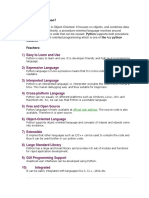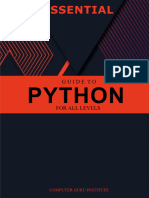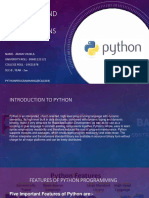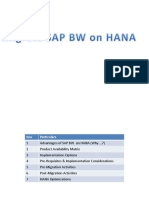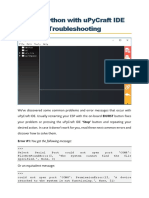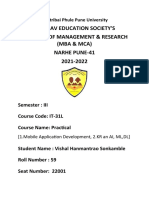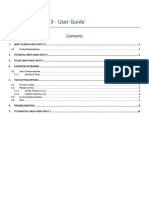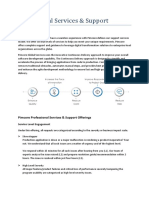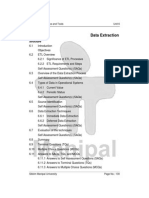1.Explain the Features of Python.
Ans:- Python is a versatile programming language known for its readability and simplicity. Here
are some key features:
1. Easy to Learn and Use: Python's syntax is clear and intuitive, making it accessible for
beginners.
2. Interpreted Language: Python is executed line by line, which makes debugging easier
and allows for interactive programming.
3. Dynamically Typed: Variables in Python do not require an explicit declaration to reserve
memory space; the declaration happens automatically when a value is assigned.
4. Extensive Libraries and Frameworks: Python boasts a rich set of libraries (like
NumPy, Pandas, and Matplotlib) and frameworks (such as Django and Flask) for various
applications, including web development and data analysis.
5. Cross-Platform Compatibility: Python can run on various operating systems, such as
Windows, macOS, and Linux, without requiring code modification.
6. Object-Oriented: Python supports object-oriented programming (OOP) principles,
allowing for the creation of reusable and modular code.
7. Rich Community Support: A large, active community provides resources,
documentation, and libraries, enhancing the development experience.
8. Extensibility: Python can be integrated with other languages (like C/C++), allowing
developers to optimize performance-sensitive components.
9. Versatile Applications: It is used in web development, data science, artificial
intelligence, automation, and more, making it a general-purpose language.
10. Support for Functional Programming: Python supports functional programming
paradigms, including higher-order functions, map, filter, and lambda functions.
These features make Python a popular choice for beginners and experienced developers alike.
2.List down the application of python.
Ans:-Python has a wide range of applications across various fields. Here are some key areas
where Python is commonly used:
1. Web Development: Frameworks like Django and Flask facilitate building dynamic
websites and web applications.
2. Data Science and Analytics: Libraries like Pandas, NumPy, and Matplotlib enable data
manipulation, analysis, and visualization.
3. Machine Learning and Artificial Intelligence: Frameworks such as TensorFlow and
Scikit-learn support building and training machine learning models.
4. Automation and Scripting: Python is often used for automating repetitive tasks, such
as file manipulation and web scraping.
5. Game Development: Libraries like Pygame allow developers to create games and
interactive applications.
� 6. Internet of Things (IoT): Python can be used to program IoT devices, thanks to its
simplicity and efficiency.
7. Desktop Applications: Tools like Tkinter and PyQt enable the development of
cross-platform desktop applications.
8. Scientific Computing: Python is widely used in scientific research for simulations,
computations, and data analysis.
9. Network Programming: Python’s libraries support creating and managing network
applications, including servers and clients.
10. Cybersecurity: Python is used in penetration testing, security automation, and creating
security tools.
11. Education: Its simplicity makes Python an ideal language for teaching programming
concepts.
12. Finance and Trading: Python is employed in quantitative finance for algorithmic trading
and financial modeling.
These applications demonstrate Python's versatility and its ability to adapt to various domains.
3.What do you mean by dynamic typing in python.
Ans:-Dynamic typing in Python means that the type of a variable is determined at
runtime, rather than in advance through explicit declarations. This allows you to assign
different types of values to the same variable without needing to specify the type
explicitly.
For example:
x = 10 # x is an integer
x = "Hello" # Now x is a string
In this example, the variable x can hold an integer initially and then be reassigned to a
string. This flexibility simplifies coding but can lead to type-related errors if not managed
carefully.



